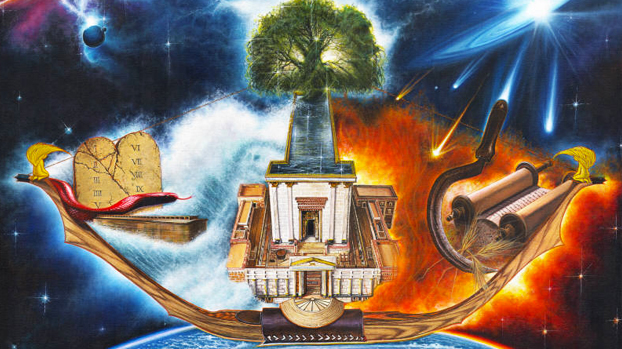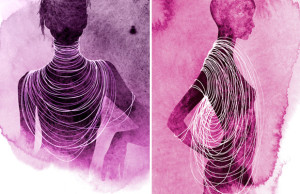
Written by C. Garbell. Garbell, a first-time Jewrotica writer, is a graduate of NYU in the Department of Media, Culture and Communication.
Garbell wrote “Online Erotica & The Space to Move Forward: A Modern Jewish Sexual Ethic” for her senior honors thesis in May 2013. The thesis, which was overseen by Professor Brett Gary, is dedicated to “those friends, teachers, and surprising men who have forced me to recon with my Judaism and with myself”. The piece is being published on Jewrotica over four consecutive days, and this is part three. Part two is available here.
PART THREE
 Rav Kahana lay under the bed of Rav, who was carousing and speaking frivolously with his wife about sexual matters; afterward, [Rav] had sexual intercourse with her. Rav Kahana said to Rav: “You appear to me like a hungry man who has never had sex before, for you act with frivolity in your lust.” He [Rav] said to Kahana: “Are you here? Get out! It is improper for you to lie under my bed!” [Kahana] said to him: “This is Torah, and I must learn.” (42)
Rav Kahana lay under the bed of Rav, who was carousing and speaking frivolously with his wife about sexual matters; afterward, [Rav] had sexual intercourse with her. Rav Kahana said to Rav: “You appear to me like a hungry man who has never had sex before, for you act with frivolity in your lust.” He [Rav] said to Kahana: “Are you here? Get out! It is improper for you to lie under my bed!” [Kahana] said to him: “This is Torah, and I must learn.” (42)
Rav was right, Kahana was indeed acting inappropriately. And yet there was an inherent truth in his defense, “for this is Torah, and I must learn.” Torah is every aspect of life, and not simply the Five Books of Moses, the Old Testament. It is the Talmud – the Oral tradition that Orthodoxy views as the complementary half of the Written Torah, both which come from God. It is every law code, parable, and commentary, every bit of philosophy, contemporary responsa, and argument over what it means to be Jewish. Torah creates an entire framework in which to relate to and make sense of the world. Jews are a people of the book in the most literal sense, for it is this textually embedded tradition that has allowed for millennia of evolving sustainability and is what makes Judaism Jewish (43). Torah, “the teaching,” is knowledge, but it is also the creation of knowledge through the power wielded by those with traditional access to knowledge.
It is an acquaintance with knowledge and thereby the means of production that allows for the continued creation of further knowledge. Historically (and quite often in much of the present) this is a power wielded by male rabbis over life and the body in order to contain and delineate between what is sacred and what is ordinary – from the orgasm that conceives to the box that holds the body after death. While the juridico-discursive aspect of this power can often be destructive or harmful, overly regulatory and set in its ways, it can also be deeply productive in the creation of worlds of meaning, systems of belief and value, of sacrity, sanctity, and pleasure.
In Ellen Willis’ 1977 Rolling Stone article, “Next Year in Jerusalem,” she explains after a long encounter in an Orthodox Jewish community,
shaping and focusing their energies toward the only meaningful end.
It was an arduous discipline, but one that was no more inherently
compulsive than my own search for the precise adjective, or the care
with which feminists analyzed the minutiae of sexual relationships.
This continued production of power and of spheres of knowledge is an essential idea in Torah; for it is indeed an “etz chaim,” (45) a living Torah that is mutable and shifting, varied and complex in its application across the generations, yet still loyal to it’s logical architecture and literary structure. “Lo bashamayim hi” the Rabbis once shout at God in a parable in the Talmud – God had been interfering in an argument over the interpretation of a law, and the Rabbis must remind Him that the Torah “Is not in heaven.” (46) It has been given to human beings to serve as their guide on earth, and to be interpreted as they are able. God gave them this tool and must let them use it. As such, “Eilu vEilu divrei Elokim chaim,” “these and these are the words of the living God.” (47)
The multiplicity of ideas and interpretations that naturally arise in the investigation of a Godly text must each be right in their own way, even if at the end of the day one practical application must be chosen. Each of these concepts comes to illustrate that the Torah – the breadth of human knowledge that is contained within that one small word – is a living, breathing guide to life, one that creates community and ideas of sacred space and time while allowing for ideas and arguments and new interpretations to arise and flourish as context and culture allow.
This idea of a living source of knowledge that is constantly transmitted allows for parallels between it and the enlivened qualities of media and the way that knowledge is transmitted in the age of the Internet. In Haunted Media, Jeffrey Sconce explores the idea of the “liveness” of technology, following the development of five forms of media- telegraphy, wireless, radio and network broadcasting, television, and TV and computers. Sconce speaks of a technology that has become like a living extension of the human “nervous system,” transmitting a spark of consciousness (48) and creating a “temporal immediacy amid spatial isolation.” (49)
Torah does that from generation to generation, bridging space and time to speak in the moment and beyond the moment. Technology, particularly the internet today, transmits a similar of-the-present “sentient immediacy,” continuing the “revelation” that accompanies each new addition to the vast world that is the Web. I argue that Jewrotica.org is the modern Torah in the modern technology, transmitting and creating knowledge, balancing power and allowing for discussion to flourish, all the while creating community around the world through a re-imagined space of Torah that reproduces old knowledge while creating new.
You may also like...
-

[button link="https://jewrotica.org/tag/pg/" color="#ff0066" size="3" style="1" dark="0" radius="auto" target="self"]PG[/button] [button link="https://jewrotica.org/tag/pg-13/" color="#ff0066" size="3" style="1" dark="0" radius="auto" target="self"]PG-13[/button] [button link="https://jewrotica.org/tag/rated-r/" color="#ff0066" size="3" style="1" dark="0" radius="auto" target="self"]R[/button] [button link="https://jewrotica.org/tag/xxx/" color="#ff0066" size="3" style="1" dark="0" radius="auto" target="self"]XXX[/button]




Like Us!
-
-
 jewrotica | February 18, 2023
jewrotica | February 18, 2023
Celebrating 10 Years & Marking the End of An Amazing Project
-
 jewrotica | November 23, 2016
jewrotica | November 23, 2016
-
 jewrotica | February 14, 2015
jewrotica | February 14, 2015
-
 sarah | February 28, 2013
sarah | February 28, 2013
-
 Karalyn | February 27, 2013
Karalyn | February 27, 2013
-
 Hugo Schwyzer | November 13, 2012
Hugo Schwyzer | November 13, 2012
-
 jewrotica | February 18, 2023
jewrotica | February 18, 2023
Celebrating 10 Years & Marking the End of An Amazing Project
-
 jewrotica | November 23, 2016
jewrotica | November 23, 2016
-
 jewrotica | February 14, 2015
jewrotica | February 14, 2015
-
 Arturo Desimone | May 2, 2019
Arturo Desimone | May 2, 2019
-
 Joseph Dunsay | May 1, 2019
Joseph Dunsay | May 1, 2019
-
Testimonials
I had a great time deejaying at the Jewrotica event at Columbia University. The live readings were hilarious, informative, and in some cases, deeply moving. I know that I, along with many of my AEPi fraternity brothers, loved being able to connect our Judaism and our sexuality in a way that made all of us feel comfortable and welcome. I look forward to being a part of this again in the future!
Michael Richmond, Columbia University Class of ’13Jewrotica is inspiring Jews and erotica with holiness and coolness, and is the pride of progressive Judaism. Jewrotica – awesome!
Shimon Weiss, Wine Maker in Agua Dolce, CAI stepped out of my comfort zone to be a part of this. I was glad to open up the topic of sexuality in my community. We are trying to build a safe space to talk about sex. The result I am most happy about coming from this event is that hopefully now my friends know they can come and talk to me, that I can be their ‘safe space’.
Barnard College Student, Presenter at the Columbia University Kickoff EventJewrotica was everything I had dreamed of and more: sexy attendees, tantalizing confessions, and well-written literature to boot! More importantly, it empowers us Jews to reach inside and own our sexy selves and heritage!
Erin L., University of Texas at Austin Social Work Graduate StudentI attended and participated in last month’s Jewrotica event. The engaging performers and Ayo, our inviting host, inspired the audience to feel like one big community. What a great way to inspire our community to embrace sex as a beautiful thing that can be fun, exciting, sacred, sensual, ridiculous, scary and everything in between!
Sabrina Must, Author and Jewish Educator from Baltimore MDI’m so glad that Jewrotica is represented here at Jewlicious! It’s bringing voices that need to be heard in the Jewish discussion and Jewish climate environment.
Ramona Rubin, Grassroots Activist in Berkeley, CAWhile many people fear the “sex talk,” Jewrotica offers an opportunity for writers and audiences to speak about sexuality in a open and safe space. When I attended a Jewrotica reading, I heard stories that reminded me that love takes many forms, and that expressing it is a vital part of who we are as a people.
Leora, Young Professional from Washington DCI love the inclusiveness – there is something for everyone, in and out of the Jewish community.
Delma Catalina, Student Leader at Texas State UniversityJewrotica is a great way to ask interesting questions about the interplay between sensuality and Jewish wisdom. Check it out.
Marcus J. Freed, Educator, Innovator, Author and Yoga Instructor in Los Angeles, CAJewrotica is something that the community has needed for a long time so that people can actually learn, express and share and have good relationships without having to stumble through life. Check out the site and learn something. Have fun!
Josh Kaplan, Jewish Community Organizer in Orange County, CADear Jewrotica
Confess
Copyright © 2014 Jewrotica.org. All Rights Reserved.
Built with Love and Mischief.
Designed by Ayo Oppenheimer and
David Abitbol





0 comments